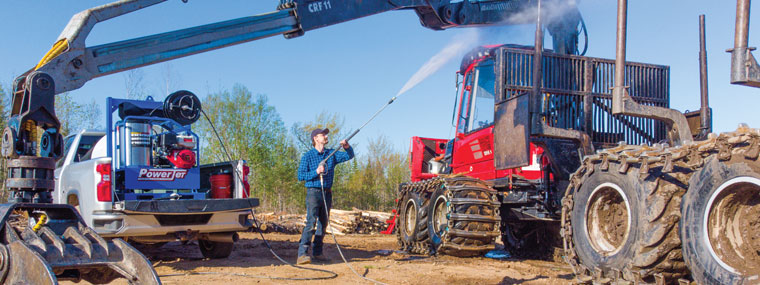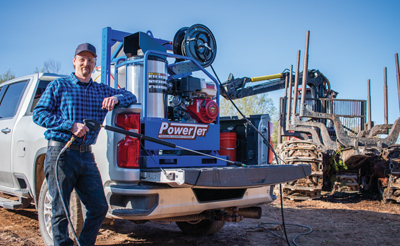
Not Seeing the Forest for the Trees
Pressure Washers in the Forestry Field
By Diane M. Calabrese / Published July 2023

Sure, “not seeing the forest for the trees” is a possibility. Yet so, too, is not seeing the trees for the forest.
Members of our industry seeking new niches to serve should take note of the trees everywhere, including urban settings. From the scarifier used to prepare soil for reforestation plantings to the harvesters with hydraulically powered cutting heads that fell standing timber, there are machines and ancillaries unique to the forestry field. They are supported with familiar tires, tracks, and trucks. All must be cleaned.
Like any machines doing hard and heavy work, those across forestry heat up. Keeping them free of errant oil-based residue is part of safe practices.
“There’s a huge market for pressure washers among loggers,” says Brad Howland, president of PowerJet Pressure Cleaning Systems in Sussex Corner, NB, Canada. “In the logging industry the hot water pressure washers are a necessity.”
Using a cold wash to keep equipment cool has its limitations on lifting off residue. “It’s like brushing your teeth without toothpaste when hot water is not used in cleaning,” says Howland.
“The hot water machine is primarily the machine they need to remove oil and grease from radiators,” explains Howland. But it’s not just the equipment in use by felling crews; the harvesters, feller-bunchers, forwarders, etc. also signal opportunities for members of our industry.
Sawmills may use pressure washers to remove ice from logs before the logs are debarked and begin their path through the saw line, explains Howland. And sawmills also need cleaning tools to assist with degreasing equipment.
Then there are the scales. Weights are taken at many junctures as log lengths move from harvest site to landing or mill (whether lumber or pulp). Buyers and brokers want to agree with sellers on weight, and log trucks want to load right up to the legal road limit, but not a bit over it.
“Pressure washers are used in pulp mills for washing the scales,” says Howland. “The scales need to be cleaned so they weigh the right amount.”
In mills, a high-pressure waterjet is used to cut the edge of paper rolls. It’s clean, sharp, and fast, which avoids compression of layers along the cut line.
As for which types of pressure washers are used in particular settings, there’s a bit of a dichotomy. “In sawmills it’s always electric,” says Howland. “In the woods it’s gas or diesel.”
“The pressure washers are primarily hot water,” says Howland. “Some cold water machines are used in paper mills,” he remarks.
Integral to Howland’s company is the attention to reducing time and labor costs for the end user. That includes providing custom-designed systems.
Howland explains that fire prevention is an essential component of logging. Keeping machines clean supports the effort.
To facilitate cleaning in the field, Howland’s company offers a 100-gallon hydraulic-driven pressure washing system capable of 3000 psi. It can be used to clean tracks and radiators every day.
Howland sees great potential for small machines with small tanks that loggers can use in the field. (For loggers in many regions, carrying tanks of water to jobsites is something they already do because they must follow the procedures for fire prevention established by regulators.)
A cleaning system that can ride onboard a harvester or a forwarder and be available for immediate use simplifies things for a logger. Streamlining is something of a watchword for the logging industry in 2023.
Yes, a chainsaw is sometimes de-ployed in Eastern forests. Wire, rope, and rigging are part of the tethering approach in Western forests, but the machines that can fell and cut to length while measuring and recording lengths by species have overtaken the industry. Equipment operators can sit in comfortable cabs with high-tech, computerized controls that tally in real-time.
When loggers head to Howland’s company for customized or ready-made cleaning systems, they are dealing with someone who knows their industry in two ways: one, decades of service; two, logging experience.
Howland owns 1000 acres of timberland. His logging equipment includes a skidder, a Link-Belt 300, a Timberjack excavator, and articulating dozers. There is no better way to serve the needs of an industry than having some immersion in it.
Look In Every Direction
Tigercat® is one well-known name in forestry harvesting systems (and specialized off-road heavy machines). It is headquartered in Brantford, ON, Canada. The company offers a tutor-
ial on cleaning online at www.tigercat.com/service-tips/keeping-it-clean-3.
The matter-of-fact tutorial begins with the reminder that for logging equipment mud and dust are just part of the day, but machine longevity is enhanced by keeping equipment clean. Hot water and pressure of 1200 psi or below with mild detergent soap is the recommendation for a cleaning approach.
Radiator cleaning, not a unique requirement for loggers, requires low psi—perhaps well under 100 psi, depending upon the composition and construction of the radiator. The goal is to clear debris, which can include wood and bark chips, leaves, and needles as well as dirt and dust. All this must be done without causing any damage to the baffles.
Each OEM [original equipment manufacturer] provides recommendations for cleaning logging equipment. For distributors and manufacturers serving regions where logging contributes to the economy, taking the time to get to know which equipment predominates in the area is a good start to serving loggers.
Smaller logging operations generally use the smallest and most compact fellers possible. Their machines would not likely support onboard cleaning systems, but they still need pressure washers for cleaning. The small loggers make a good customer base for the sale of hot water pressure washers.
Contractors in logging areas can find many ways to serve loggers. For contractors who already have a mobile operation equipped with trailer-riding water tanks, reaching out to loggers can add to the customer base.
 Some loggers process—delimb and cut to shorter lengths—at a landing (where trees and logs are gathered and sorted before further processing and transport to a mill or log yard facility). The landing itself requires periodic cleaning.
Some loggers process—delimb and cut to shorter lengths—at a landing (where trees and logs are gathered and sorted before further processing and transport to a mill or log yard facility). The landing itself requires periodic cleaning.
For many reasons, such as encouragement from trade groups, foresters, and community leaders, many loggers now open their operations to visitors occasionally. Take the opportunity for such a visit to get a firsthand look at equipment and methods—and to think about how pressure washers and ancillaries might better serve the forestry sector.
Also assess the full scope of equipment used in the forestry field. Logging trucks and support trucks must all be cleaned. In regions where logging has a big presence, fleet washing systems for logging trucks are often in place. They are heavy-duty systems that frequently include steam cleaning as an assist in removing caked-on mud and debris.
No one along the chain from tree to mill wants a dirty log truck to do the transport, especially not an independent truck operator. If that operator is adding weight with dirt instead of logs, he or she sacrifices money. At the same time, the mill wants to know that what’s being weighed when a load arrives in the yard is a load of logs, not dirt and logs.
In urban settings it’s common to see small chippers in use by tree trimmers. The machines seem quite powerful, ingesting hardwood branches and spitting out chips. But they are no match for some of the big grinders in use by loggers and mill operators who grind wood waste for mulch or for chips that head to pulp and paper mills, and increasingly to biofuel generating facilities.
The hammering and crushing power of some of the big tub grinders depends on the same principles used in rock-crushing machines. They use torque conversion to protect the engine, keeping it near governed speed even as the machine devours big piles of tops and smaller limbs.
Some huge single-path grinders can take in an entire tree along a conveyor at one end and spew chips at the other. The single-step in field—harvest and pulverize fiber, haul away chips—is a popular way to consolidate steps. The chips head mostly to pulp and paper mills.
Chippers, grinders (tub and conveyor), chip trucks, etc. must all be cleaned. There are more opportunities in every direction an enterprising maker or seller of pressure washers looks.
According to the National Association of State Foresters, U.S. forests cover 800 million acres and account for an amazing 7.5 percent of the world’s forests. The federal government owns and manages approximately 30 percent.
That’s an important 30 percent because the management comes via entities besides the USDA Forest Service, such as the Bureau of Land Management, U.S. National Park Service, and Department of Defense. Each group contracts for its equipment and service needs. Be sure to consider helping them meet their forestry equipment cleaning needs, which are typically bid out with great specificity—e.g., size (length of hose, tank size), capabilities (horse-power, gpm), and even the type of trailer.
Whether loggers are using cable systems in the Pacific Northwest or compact harvesters in the Upper Great Lakes region, their equipment must be cleaned. When assessing opportunities to connect with the forestry field via pressure washers and ancillaries or steam cleaners, be sure to look at all the possibilities—the “trees” and the “forest.”





